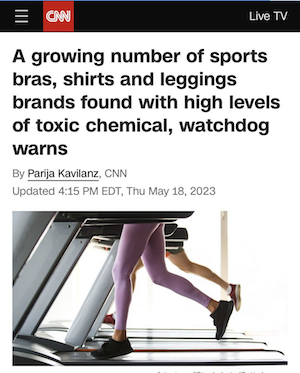Be aware that when you tight polyester leggings and sports bras they can release PFAS and BPAs into very sensitive areas of your body!

Wearing polyester leggings and sports bras that release PFAS (Per- and polyfluoroalkyl substances) and BPAs (Bisphenol A) can pose several health risks due to the nature of these chemicals:
1. PFAS (Per- and polyfluoroalkyl substances):
- Sources:
- PFAS are often used in textiles to provide water and stain resistance, which is why they might be found in moisture-wicking or water-resistant sportswear.
- Risks:
- Endocrine Disruption: PFAS are known as ‘forever chemicals’ because they do not break down in the environment or the body easily. They can interfere with hormone levels, potentially leading to reproductive issues, developmental effects in children, and possibly increasing cancer risk.
- Immune System Impact: Exposure to PFAS has been linked to reduced vaccine response and immune system dysfunction.
- Other Health Concerns: There are associations with increased cholesterol levels, liver damage, and thyroid disease.
- Exposure:
- When you sweat in these garments, the chemicals can be absorbed through the skin, increasing direct exposure. PFAS can accumulate in the body over time due to their persistent nature.
2. BPA (Bisphenol A):
- Sources:
- BPA is often used in the production of polyester to improve its properties like durability and static resistance. It can also be present in the dyes or coatings used in textiles.
- Risks:
- Endocrine Disruption: Like PFAS, BPA can mimic or block hormones, leading to hormone imbalances. This disruption can affect fertility, development, and might increase the risk of certain cancers like breast, prostate, or ovarian cancer.
- Developmental Effects: Prenatal exposure to BPA has been linked to various health issues in offspring, including behavioral changes, obesity, and metabolic disorders.
- Cardiovascular and Other Health Issues: There’s some evidence suggesting links to heart disease, diabetes, and asthma.
- Exposure:
- BPA can leach from clothing, especially when heated by body temperature or sweat, directly into the skin where it can be absorbed.
General Points:
- Skin Absorption: Both PFAS and BPA can be absorbed through the skin, particularly in areas where sweat accumulates or where the fabric is in close, prolonged contact with sensitive skin areas like the breasts or crotch.
- Regulation and Awareness:
- There’s growing concern and research into these chemicals, leading to some regulatory actions in places like California with Proposition 65, which sets limits on BPA exposure. However, regulations vary by region, and global standards are still evolving.
- Alternatives:
- Manufacturers are increasingly aware of these issues, leading to a rise in PFAS and BPA-free workout clothing options using materials like organic cotton, bamboo, or other natural fibers.
When considering the risks, it’s important to understand that while these chemicals are present in many products, the exact level of exposure and resulting health impact can vary widely depending on numerous factors including the duration of wear, the amount of chemical in the fabric, individual physiological responses, and cumulative exposure from other sources. However, reducing exposure where possible, especially in clothing that is in contact with the skin for extended periods, is a prudent approach.
In reality, finding alternatives for waterproofing alone hasn’t been too difficult. Go here to learn more about these chemicals and where you can find alternatives.
https://www.cnn.com/cnn-underscored/outdoors/best-pfas-free-non-toxic-apparel-shoes